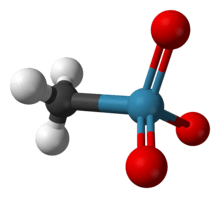Methylrhenium trioxide
Methylrhenium trioxide, also known as methyltrioxorhenium, is an organometallic compound with the formula CH3ReO3. It is a volatile, colourless solid that has been used as a catalyst in some laboratory experiments. In this compound, Re has a tetrahedral coordination geometry with one methyl and three oxo ligands. The oxidation state of rhenium is +7.
 | |
| Names | |
|---|---|
| Other names
methyltrioxorhenium | |
| Identifiers | |
3D model (JSmol) |
|
| ChemSpider | |
| ECHA InfoCard | 100.202.821 |
PubChem CID |
|
| UNII | |
CompTox Dashboard (EPA) |
|
| |
| |
| Properties | |
| CH3ReO3 | |
| Molar mass | 249.24 g/mol |
| Appearance | white powder |
| Melting point | 112 °C (234 °F; 385 K) |
| highly soluble in water | |
| Hazards | |
| Safety data sheet | External MSDS |
| GHS pictograms |   |
| GHS Signal word | Warning |
GHS hazard statements |
H272, H315, H319, H335, H413 |
| P210, P220, P221, P261, P264, P271, P273, P280, P302+352, P304+340, P305+351+338, P312, P321, P332+313, P337+313, P362, P370+378, P403+233, P405, P501 | |
Except where otherwise noted, data are given for materials in their standard state (at 25 °C [77 °F], 100 kPa). | |
| Infobox references | |
Synthesis
Methylrhenium trioxide is commercially available. It can be prepared by many routes, a typical method is the reaction of Re2O7 and tetramethyltin:[1]
- Re2O7 + (CH3)4Sn → CH3ReO3 + (CH3)3SnOReO3
Analogous alkyl and aryl derivatives are known. Compounds of the type RReO3 are Lewis acids, forming both 1:1 and 1:2 adducts with halides and amines.
Uses
Methylrhenium trioxide serves as a heterogeneous catalyst for a variety of transformations. Supported on Al2O3/SiO2, it catalyzes olefin metathesis at 25 °C.
In solution, MTO catalyses for the oxidations with hydrogen peroxide. Terminal alkynes yield the corresponding acid or ester, internal alkynes yield diketones, and alkenes give epoxides. MTO also catalyses the conversion of aldehydes and diazoalkanes into an alkene,[2] and the oxidation of amines to N-oxides with sodium percarbonate.[3]
References
- Herrmann, W. A.; Kratzer R. M.; Fischer R. W. (1997). "Alkylrhenium Oxides from Perrhenates: A New, Economical Access to Organometallic Oxide Catalysts". Angew. Chem. Int. Ed. Engl. 36 (23): 2652–2654. doi:10.1002/anie.199726521.
- Hudson, A. “Methyltrioxorhenium” Encyclopedia of Reagents for Organic Synthesis. John Wiley & Sons: New York, 2002.
- Jain, Suman L.; Joseph, Jomy K.; Sain, Bir (2006). "Rhenium-Catalyzed Highly Efficient Oxidations of Tertiary Nitrogen Compounds to N-Oxides Using Sodium Percarbonate as Oxygen Source". Synlett: 2661–2663. doi:10.1055/s-2006-951487.